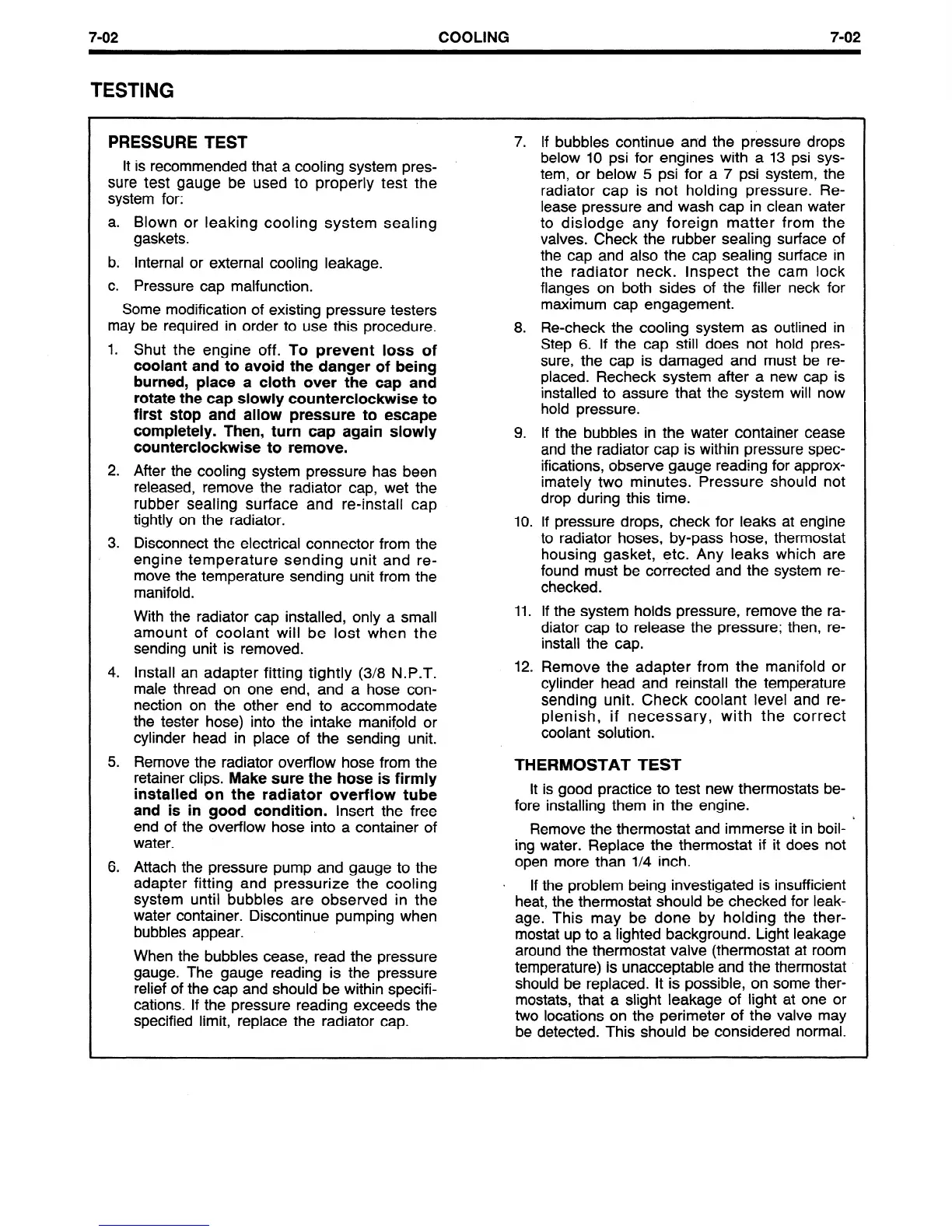7-02
COOLING
7-02
TESTING
It is recommended that a cooling system pres-
sure test gauge be used to properly test the
system for:
a. Blown or leaking cooling system sealing
gaskets.
b. Internal or external cooling leakage.
c. Pressure cap malfunction.
Some modification of existing pressure testers
may be required in order to use this procedure.
1. Shut the engine off.
To prevent loss of
coolant and to avoid the danger of being
burned, place a cloth over the cap and
rotate the cap slowly counterclockwise to
first stop and allow pressure to escape
completely. Then, turn cap again slowly
counterclockwise to remove.
2. After the cooling system pressure has been
released, remove the radiator cap, wet the
rubber sealing surface and re-install cap
tightly on the radiator.
3. Disconnect the electrical connector from the
engine temperature sending unit and re-
move the temperature sending unit from the
manifold.
With the radiator cap installed, only a small
amount of coolant will be lost when the
sending unit is removed.
4. Install an adapter fitting tightly (3/8 N.P.T.
male thread on one end, and a hose con-
nection on the other end to accommodate
the tester hose) into the intake manifold or
cylinder head in place of the sending unit.
5. Remove the radiator overflow hose from the
retainer clips.
Make sure the hose is firmly
installed on the radiator overflow tube
and is in good condition.
Insert the free
end of the overflow hose into a container of
water.
6. Attach the pressure pump and gauge to the
adapter fitting and pressurize the cooling
system until bubbles are observed in the
water container. Discontinue pumping when
bubbles appear.
When the bubbles cease, read the pressure
gauge. The gauge reading is the pressure
relief of the cap and should be within specifi-
cations. If the pressure reading exceeds the
specified limit, replace the radiator cap.
7.
If bubbles continue and the pressure drops
below 10 psi for engines with a 13 psi sys-
tem, or below 5 psi for a 7 psi system, the
radiator cap is not holding pressure. Re-
lease pressure and wash cap in clean water
to dislodge any foreign matter from the
valves. Check the rubber sealing surface of
the cap and also the cap sealing surface in
the radiator neck. Inspect the cam lock
flanges on both sides of the filler neck for
maximum cap engagement.
8. Recheck the cooling system as outlined in
Step 6. If the cap still does not hold pres-
sure, the cap is damaged and must be re-
placed. Recheck system after a new cap is
installed to assure that the system will now
hold pressure.
9. If the bubbles in the water container cease
and the radiator cap is within pressure spec-
ifications, observe
gauge
reading for approx-
imately two minutes. Pressure should not
drop during this time.
10. If pressure drops, check for leaks at engine
to radiator hoses, by-pass hose, thermostat
housing gasket, etc. Any leaks which are
found must be corrected and the system re-
checked.
11. If the system holds pressure, remove the ra-
diator cap to release the pressure; then, re-
install the cap.
12. Remove the adapter from the manifold or
cylinder head and reinstall the temperature
sending unit. Check coolant level and re-
plenish, if necessary, with the correct
coolant solution.
THERMOSTAT TEST
It is good practice to test new thermostats be-
fore installing them in the engine.
Remove the thermostat and immerse it in boil-
ing water. Replace the thermostat if it does not
open more than l/4 inch.
If the problem being investigated is insufficient
heat, the thermostat should be checked for leak-
age. This may be done by holding the ther-
mostat up to a lighted background. Light leakage
around the thermostat valve (thermostat at room
temperature) is unacceptable and the thermostat
should be replaced. It is possible, on some ther-
mostats, that a slight leakage of light at one or
two locations on the perimeter of the valve may
be detected. This should be considered normal.

